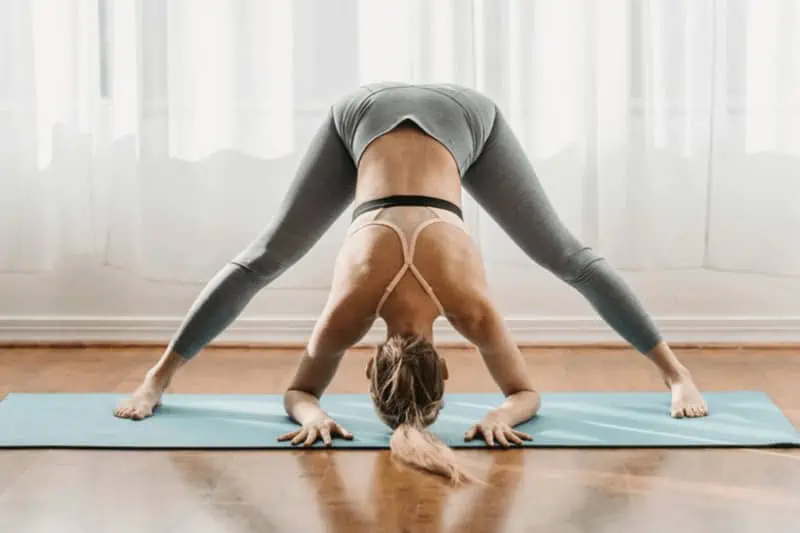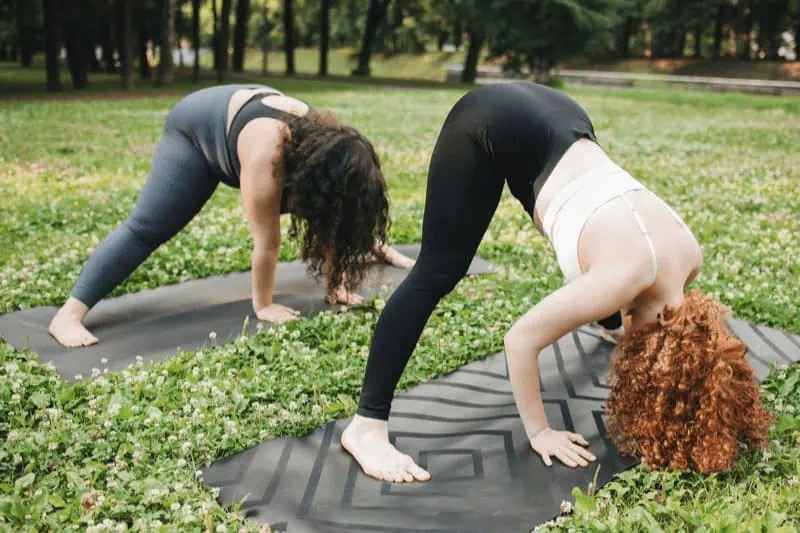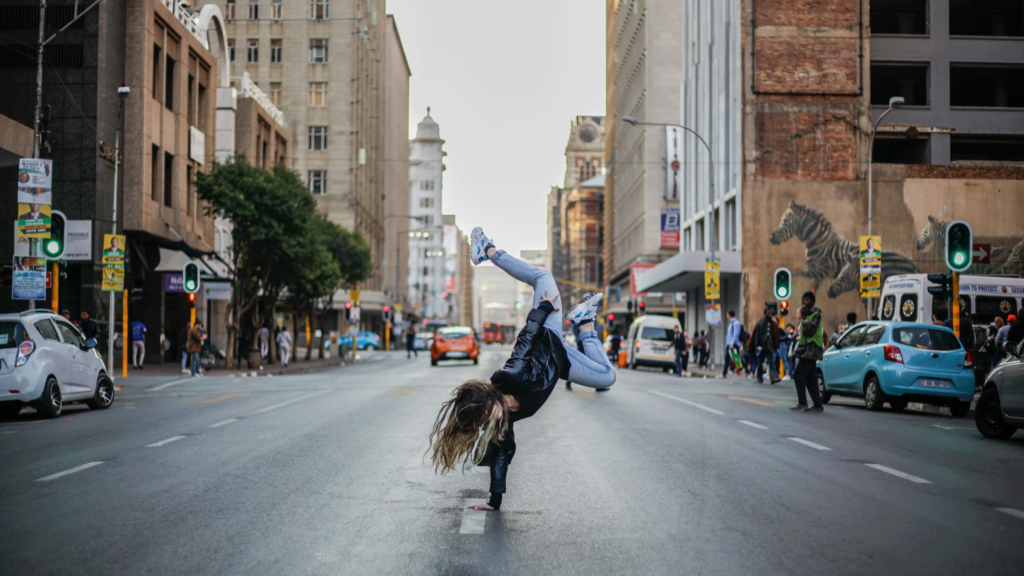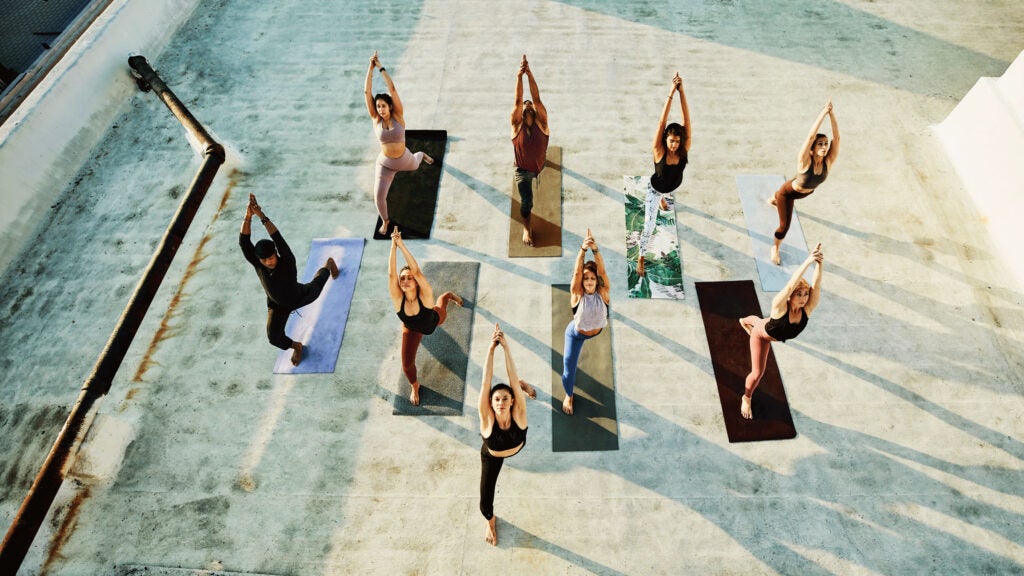A few of my favourite poses as a yoga instructor are probably the most versatile. There are a lot of causes individuals take up yoga, whether or not they purpose to develop into stronger, extra versatile, or much less harassed. So, after I’m educating a category, I really like together with poses that profit a bunch of scholars with numerous targets.
Prasarita Padottanasana, or Extensive Legged Ahead Bend Pose, checks many containers, making this posture a go-to stretch in lots of my yoga sequences.
It’s versatile not solely in its anatomy however in its operate as effectively. You’ll be able to add this posture to a sequence targeted on standing poses, leg stretches, balancing, or inversions. Add some arm variations, and create inventive flows with the Extensive Legged Standing Ahead Bend.
Be part of me as we uncover the potential of Prasarita Padotanasana. We’ll provide clear steps for practising safely and steerage for including this asana to your personal yoga sequences. Plus, you’ll study this asana’s title, anatomy, and the way it might help your physique and thoughts.
Roll out your mat, and let’s dive in!
Asana Overview
Extensive Legged Ahead Fold is a foundational however comparatively fashionable yoga pose. It emerged within the library of asanas within the early twentieth century when T. Krishnamacharya described Prasarita Padottanasana within the Yoga Makaranda.

Yoga protocol classifies this beginner-level asana with standing poses, inversions, and ahead folds. Many individuals be taught this posture as a part of the Ashtanga Yoga main collection sequence, which defines 4 completely different place variations.
English and Sanskrit Names
It may be a mouthful whether or not you utilize the English or Sanskrit title for this asana! However I’ve discovered that when you research the Sanskrit names of various postures, the knowledge might help you be taught new poses as you start to acknowledge smaller elements of lengthy names.
Check out how Prasarita Padottanasana comes collectively:
Prasarita: unfold out, extensive
Pada: foot
Uttana: stretched out
Asana: posture
Can you discover some cues included within the title? It’s possible you’ll acknowledge “uttanasana” because the Sanskrit title for Standing Ahead Bend. So, you’ll know that Prasarita Padottanasana can also be a ahead fold. The primary a part of the title offers one other clear course on this case, telling you to separate your ft.
Now that you realize the which means of the Sanskrit phrase pada, you don’t need to be a yoga instructor to guess that any asana containing that phrase in its title should have one thing to do together with your ft. Simple, proper?
It’s not all the time simple to pronounce the Sanskrit title accurately — even yoga academics generally want steerage. While you say the Sanskrit title for Extensive Legged Ahead Fold, emphasize the proper syllables: “prah-SAR-ee-tah PAH-doh-TAN-NAH-sah-nah.”
Anatomy of Prasarita Padottanasana
Earlier than we undergo the steps of practising this pose, right here’s a fast overview of what muscle groups are concerned on this posture:
Lengthening: Hamstrings, adductors (internal thighs), calf muscle groups. Relying on whether or not you add an arm variation, you may as well stretch the shoulders and chest.
Strengthening: Stomach muscle groups, erector spinae, and quadratus lumborum (again muscle groups)
Now that you realize what the expertise entails, it’s time to strive it out.
Step-by-Step Information to Prasarita Padottanasana
Extensive Legged Ahead Bend Pose could be a dynamic or restorative expertise, however both method, it requires a stable basis and correct alignment. Observe these steps to excellent your Prasarita Padottanasana type.
Appropriate Set-Up
Start standing in Mountain Pose. Take a giant step open and switch to the facet, going through the lengthy fringe of your yoga mat.
Your ft ought to be separated wider than hip distance.
Flip your toes ahead so every foot is parallel to the quick edges of your mat.
Floor down by means of the outer edges of your ft to create a steady base.
Getting into the Pose
Place your arms in your hips. As you inhale, develop taller as you lengthen your backbone.
Exhale and hinge out of your hips, maintaining your backbone straight.
Carry your arms onto the ground beneath your shoulders as you launch your higher physique into your ahead fold. Let your head grasp together with your neck relaxed.
In the event you can, place your forearms on the ground. Or, prolong your arms out to the perimeters and wrap your first two fingers round every large toe.
Hold your breath flowing simply as you maintain the stretch for five to 7 deep breaths.
Exiting Safely
While you’re prepared to come back out of the place, convey your arms to your hips.
Hold a microbend in your knees and start to roll up slowly.
Take your time and return to a standing place.
Step your ft collectively, returning to your beginning place on the prime of your mat.
Respiration guides each motion in yoga. Use your breath deliberately to get probably the most out of this pose: Discover size in your backbone with every inhale; with every exhale, launch and deepen into the stretch.

Avoiding Widespread Errors
Working towards Prasarita Padottanasana requires consideration to alignment to stay balanced and injury-free. Listed below are some teacher-approved cues and methods that can assist you nail this posture.
Arching or rounding the backbone as you fold: Be aware of sustaining size in your backbone as you bow ahead, hinging on the hips. Think about a string pulling you from the crown of your head in the direction of the ground, maintaining your backbone straight and lengthy.
Hyperextending the knees: Locking your knees strains your joints, inflicting ache. To maintain your joints secure and keep stability, have interaction your quad muscle groups and preserve a microbend in your knees.
Weight distribution: Sustaining steadiness on this pose relies upon considerably in your stance. You need your legs separated a substantial distance however not a lot that your ft collapse inward. Press down by means of the outer edges of your ft to make sure your weight is evenly distributed.
Consciousness of Contraindications
Prasarita Padottanasana could be an intense stretch, particularly for individuals with particular well being points or prior accidents. In the event you expertise any of the next, you need to method this posture cautiously or probably keep away from it altogether.
Decrease again harm or backbone points like herniated discs
Hamstring, hip, or groin accidents
Dizziness or vertigo
Glaucoma or different eye points.
You probably have any doubts about your bodily situation, seek the advice of a physician earlier than making an attempt this pose.
Modifications and Variations to Improve Prasarita Padottanasana
Prasarita Padottanasana, or the Extensive Legged Ahead Bend Pose, is a extremely adaptable pose with quite a few modifications and variations. These changes can improve the stretch for shoulders, calves, and chest whereas accommodating completely different talent ranges.
Props for Assist
Utilizing props like blocks or straps throughout Prasarita Padottanasana can present stability and help, particularly in case your hamstrings are exceptionally tight.
Blocks: In the event you discover reaching the bottom together with your arms difficult, use blocks beneath every hand to convey the bottom nearer. To assist with steadiness, place a block beneath your brow for help as you fold ahead.
Strap: Another choice when you can not comfortably grasp your ankles is to make use of a strap. Lay the strap on the ground and stand on prime. Maintain the ends of the strap in your arms and gently pull your torso towards the bottom.
Blanket: You probably have tight calves, slide a folded blanket beneath your heels. This may assist take your weight into the balls of your ft and goal the backs of your legs.
Wall: Reasonably than folding to the ground, preserve your backbone straight utilizing a wall for help. Set your mat about arm’s size in entrance of a wall. Attain your arms in entrance of you as you hinge over, strolling your arms down the wall till your torso is parallel to the ground.
Chair-Supported Adaptation
In case your mobility is restricted or you’ve gotten again ache, strive an adaptive model of Prasarita Padottanasana in a chair yoga sequence.
Set a chair a foot or two in entrance of you. Step your ft extensive and put together on your ahead fold.
Set your arms or forearms on the chair’s seat as you stretch the backs of your legs.
Set a bolster on the chair seat for additional consolation, and relaxation your brow there as you maintain the pose.
Changing into extra versatile takes persistence and consistency — not drive. In the event you’re simply beginning out, strive a prop-modified model of this posture to keep away from straining.
Arm Variation Strategies in Prasarita Padottanasana
As soon as you’re feeling comfy in your Extensive Legged Ahead Bend Pose, strive these inventive variations so as to add range to your yoga sequences.
Shoulder opener variation: From Prasarita Padottanasana, carry midway together with your backbone straight. Clasp your arms behind your decrease again and straighten your arms as you fold towards the ground. Squeeze your shoulder blades collectively as your chest opens.
Reverse prayer: This variation additionally opens your shoulders and assessments your steadiness. From Prasarita Padottanasana, carry midway and bend your elbows, bringing your palms collectively behind you in a reverse prayer place. Keep lifted together with your backbone straight to strengthen your erector spinae and core.
Revolved Prasarita Padottanasana
With this twisted model, you’ll be able to add spinal mobility to your Extensive Legged Ahead Bend Pose.
Carry your proper hand to the ground within the heart of your ft.
Press your palm firmly into the bottom as you attain your left arm to the sky, opening your chest to the facet.
Maintain the place for just a few breaths and launch, repeating the twist in your different facet.
What I really like about utilizing a variation in Prasarita Padottanasana is that it utterly adjustments the main focus of the pose. Reasonably than a deep hamstring stretch, you should use this asana to construct power and enhance higher physique mobility.
The Advantages of Extensive Legged Ahead Bend Pose

Prasarita Padottanasana affords quite a few benefits for each bodily and psychological well-being. Let’s discover a few of the prime causes for practising this useful asana.
Targets Key Muscle tissues to Alleviate Again Ache
Prasaarita Padottanasana lengthens the hamstrings and engages the erector spinae muscle groups and the quadratus lumborum muscle groups in your again.
Tight hamstrings may cause the pelvis to tilt in a method that strains the quadratus lumborum, contributing to decrease again ache. This research, specifically, means that sustaining versatile hamstrings successfully prevents creating again ache.
Enhances Flexibility
Extensive Legged Standing Ahead Bend helps improve hip mobility, which is essential for a lot of bodily actions. Maintaining your muscle groups versatile helps stop accidents and keep an optimum vary of movement within the joints.
Will increase Blood Circulation to Promote Therapeutic
This dynamic pose encourages blood move all through the physique. Improved circulation means extra oxygen-rich blood reaches your tissues, aiding in therapeutic and cell development.
Analysis from one 2014 research confirmed diminished fatigue and irritation in breast most cancers survivors who adopted a yoga protocol, which included Prasarita Padottanasana.
Relieves Stress Signs
Out of all yoga poses, inversions are particularly recognized for his or her optimistic results on psychological well-being. Inversions convey the pinnacle beneath the center, which might help calm the thoughts. Inverted yoga poses activate the parasympathetic nervous system, slowing your respiration and coronary heart charge.
Improves Digestion
The ahead fold place of Prasarita Padottanasana applies light stress on the stomach. While you carry out of the posture, your belly organs obtain a rush of contemporary blood, stimulating your digestion. This means the pose might help relieve digestive points like irritable bowel syndrome (IBS) signs.
Assuaging Headache and Insomnia
Ahead folds like Prasarita Padottanasana chill out the neck and shoulder muscle groups, which might typically be the supply of painful stress complications. Furthermore, the improved blood circulation and calming results on the nervous system can scale back ache and enable you to sleep extra restfully.
Preparatory Poses for Prasarita Padottanasana
Since this pose is an intense stretch for many individuals, all the time be sure you start with a wide range of preparatory poses that heat up your complete physique to keep away from muscle pressure. Listed below are some goal areas to concentrate on.
Heat Up the Legs
Begin with poses that loosen the muscle groups of your legs and hips.
Mountain Pose is a superb place to begin. It establishes alignment and begins to have interaction your leg muscle groups.
Standing Ahead Bend opens up your hamstrings.
Chair Pose will additional heat up your legs and stretch your calves.
Open the Hips
Yogi squat releases the muscle groups across the hip joint and opens the internal thighs.
Excessive or Low Lunge targets the hip flexors, warming them up for the flexion of bending ahead.
Launch the Again
In case your again muscle groups are tense, you danger straining as you fold into this stretch. Strive these stretches to launch stress alongside your backbone.
Youngster’s Pose releases the glutes and hips whereas stress-free the erector spinae and shoulders.
Downward Dealing with Canine lengthens the backbone, hamstrings, and backs of the ankles.
Do you want some steerage by means of these advised poses? You’ll find info in our library of poses right here.
Integrating Prasarita Padottanasana into Your Yoga Routine
Prasarita Padottanasana is a flexible posture that matches completely in numerous yoga sequences. Listed below are just a few concepts for utilizing this pose to help your subsequent yoga session.
Use in Numerous Yoga Sequences
Transition between standing postures
Calming, restorative move
Flexibility-focused sequences
Muscle launch after strengthening poses
Preparation for inversions
Ashtanga Main Sequence
In the event you’d choose the steerage of a yoga instructor slightly than placing collectively your personal yoga sequence, check out Yogadownload.com’s free on-line courses.
Complementary and Counter Poses
For many yoga academics, yoga protocol consists of complementary poses to convey concord to each yoga sequence. Within the case of Prasarita Padottanasana, I prefer to pair it with strength-building postures. Listed below are a few my solutions.
Goddess Pose: strengthens the muscle groups of the legs (quads, internal thighs, outer hip)
Headstand: builds power within the core, erector spinae, and shoulders
Or, you’ll be able to comply with up with balancing standing poses like Tree or Dancer, which have interaction the hamstrings and lengthen the quad muscle groups. The chances are infinite!
Sustaining Constant Follow
Many individuals with tight hamstrings suppose it can restrict their yoga follow. However that’s not true! The one option to develop into extra versatile is to place in follow time in your mat.
If flexibility is a aim for you, I like to recommend college students strive to do that pose a minimum of 3 or 4 occasions per week, holding the stretch for 30 seconds to 1 minute. Bear in mind to take it gradual — by no means drive your self into over-stretching, and use a modified model if wanted!

Conclusion
Prasarita Padottanasana, or Extensive Legged Standing Ahead Bend, affords many advantages and variations for college kids of all ranges. Adopting this pose into your follow can considerably enhance bodily and psychological well-being, from improved flexibility to diminished stress.
This pose has one thing for everyone and is very adaptable to completely different ranges of follow, making it a favourite for a lot of yoga academics like myself. By studying a bit about its anatomy, you’ll be able to higher perceive its advantages and learn how to get probably the most out of this pose.
Now it’s time to strive it out for your self! Use a few of the advised poses right here and get inventive. Take a large stance, launch stress, and develop into extra expansive with every breath.
Ceaselessly Requested Questions
What’s Prasarita Padottanasana?
Prasarita Padottanasana, also called Extensive-Legged Ahead Bend, is a standing yoga posture that stretches the hamstrings and again.
What are the advantages of practising Prasarita Padottanasana?
The advantages of practising Prasarita Padottanasana embody stretching the hamstrings, strengthening the core and legs, enhancing circulation and digestion, and constructing physique consciousness. It may additionally assist to calm the thoughts and relieve delicate again ache.
Who ought to keep away from doing Prasarita Padottanasana?
Folks with decrease again accidents or hamstring tears, glaucoma, or these at the moment experiencing hypertension ought to keep away from practising Prasarita Padottanasana. You probably have pre-existing well being circumstances, all the time seek the advice of a physician earlier than starting any new train routine.
Can Prasarita Padottanasana assist with stress aid?
Sure, Prasarita Padottanasana is thought for its potential to alleviate stress signs. The inverted place encourages a way of leisure and might help to ease anxiousness by calming the thoughts. It stimulates the parasympathetic nervous system, activating the physique’s rest-and-digest response.
How typically ought to one follow Prasarita Padottanasana for finest outcomes?
Incorporate Prasarita Padottanasana into your every day yoga routine for optimum outcomes. Nonetheless, frequency can differ relying on particular person health ranges and targets. Newcomers might begin by practising this pose a couple of times per week, rising frequency as flexibility and power enhance.
What are some widespread errors to keep away from in Prasarita Padottanasana?
When practising Prasarita Padottanasana, it’s necessary to keep away from rounding your again, as this will pressure your quadratus lumborum. As an alternative, purpose to fold ahead with a straight again, bending out of your hips to maintain the stretch secure and efficient.







